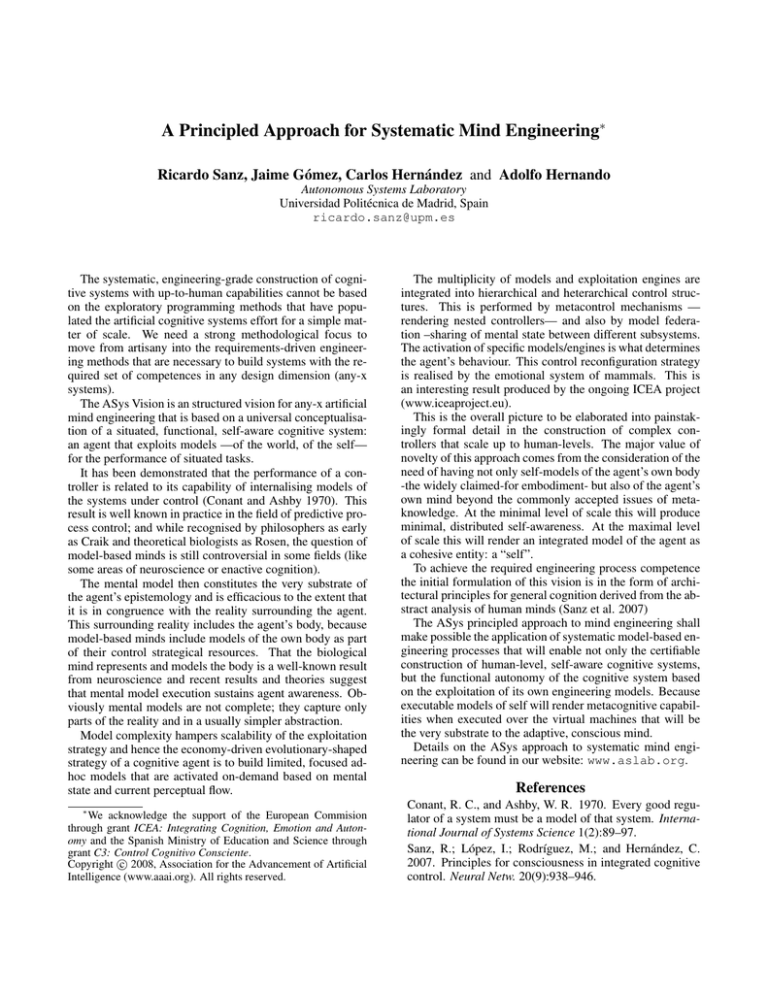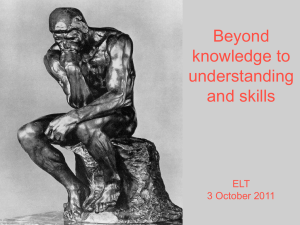
A Principled Approach for Systematic Mind Engineering∗
Ricardo Sanz, Jaime Gómez, Carlos Hernández and Adolfo Hernando
Autonomous Systems Laboratory
Universidad Politécnica de Madrid, Spain
ricardo.sanz@upm.es
The systematic, engineering-grade construction of cognitive systems with up-to-human capabilities cannot be based
on the exploratory programming methods that have populated the artificial cognitive systems effort for a simple matter of scale. We need a strong methodological focus to
move from artisany into the requirements-driven engineering methods that are necessary to build systems with the required set of competences in any design dimension (any-x
systems).
The ASys Vision is an structured vision for any-x artificial
mind engineering that is based on a universal conceptualisation of a situated, functional, self-aware cognitive system:
an agent that exploits models —of the world, of the self—
for the performance of situated tasks.
It has been demonstrated that the performance of a controller is related to its capability of internalising models of
the systems under control (Conant and Ashby 1970). This
result is well known in practice in the field of predictive process control; and while recognised by philosophers as early
as Craik and theoretical biologists as Rosen, the question of
model-based minds is still controversial in some fields (like
some areas of neuroscience or enactive cognition).
The mental model then constitutes the very substrate of
the agent’s epistemology and is efficacious to the extent that
it is in congruence with the reality surrounding the agent.
This surrounding reality includes the agent’s body, because
model-based minds include models of the own body as part
of their control strategical resources. That the biological
mind represents and models the body is a well-known result
from neuroscience and recent results and theories suggest
that mental model execution sustains agent awareness. Obviously mental models are not complete; they capture only
parts of the reality and in a usually simpler abstraction.
Model complexity hampers scalability of the exploitation
strategy and hence the economy-driven evolutionary-shaped
strategy of a cognitive agent is to build limited, focused adhoc models that are activated on-demand based on mental
state and current perceptual flow.
∗
We acknowledge the support of the European Commision
through grant ICEA: Integrating Cognition, Emotion and Autonomy and the Spanish Ministry of Education and Science through
grant C3: Control Cognitivo Consciente.
c 2008, Association for the Advancement of Artificial
Copyright Intelligence (www.aaai.org). All rights reserved.
The multiplicity of models and exploitation engines are
integrated into hierarchical and heterarchical control structures. This is performed by metacontrol mechanisms —
rendering nested controllers— and also by model federation –sharing of mental state between different subsystems.
The activation of specific models/engines is what determines
the agent’s behaviour. This control reconfiguration strategy
is realised by the emotional system of mammals. This is
an interesting result produced by the ongoing ICEA project
(www.iceaproject.eu).
This is the overall picture to be elaborated into painstakingly formal detail in the construction of complex controllers that scale up to human-levels. The major value of
novelty of this approach comes from the consideration of the
need of having not only self-models of the agent’s own body
-the widely claimed-for embodiment- but also of the agent’s
own mind beyond the commonly accepted issues of metaknowledge. At the minimal level of scale this will produce
minimal, distributed self-awareness. At the maximal level
of scale this will render an integrated model of the agent as
a cohesive entity: a “self”.
To achieve the required engineering process competence
the initial formulation of this vision is in the form of architectural principles for general cognition derived from the abstract analysis of human minds (Sanz et al. 2007)
The ASys principled approach to mind engineering shall
make possible the application of systematic model-based engineering processes that will enable not only the certifiable
construction of human-level, self-aware cognitive systems,
but the functional autonomy of the cognitive system based
on the exploitation of its own engineering models. Because
executable models of self will render metacognitive capabilities when executed over the virtual machines that will be
the very substrate to the adaptive, conscious mind.
Details on the ASys approach to systematic mind engineering can be found in our website: www.aslab.org.
References
Conant, R. C., and Ashby, W. R. 1970. Every good regulator of a system must be a model of that system. International Journal of Systems Science 1(2):89–97.
Sanz, R.; López, I.; Rodrı́guez, M.; and Hernández, C.
2007. Principles for consciousness in integrated cognitive
control. Neural Netw. 20(9):938–946.





